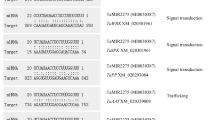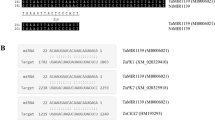Abstract
microRNAs (miRNAs) are novel and significant regulators of gene expression at the post-transcriptional level, and they are essential for normal growth and development and adaptation to stress conditions. As miRNAs are a kind of RNAs that do not code proteins, they play roles by repressing gene translation or degrading the corresponding target mRNAs. Plantacyanin-like (basic blue) proteins have been predicted and verified as the target gene of miR408 in wheat and Arabidopsis, respectively. Besides some biochemical characteristics, their detailed biological function remains unknown. In this study, the target gene of a wheat miRNA (tae-miR408), designated TaCLP1, was identified using degradome sequencing and co-transformation technology in tobacco leaves. We isolated the full-length cDNA clone, and defined its product as a chemocyanin-like protein, a kind of plantacyanin. Transcript accumulation of TaCLP1 and tae-miR408 showed contrasting divergent expression patterns in wheat response to Puccinia striiformis f. sp. tritici (Pst) and high copper ion stress. Overexpression of TaCLP1 in yeast (Schizosaccharomyces pombe) significantly increased cell growth under high salinity and Cu2+ stresses. Silencing of individual cDNA clones in wheat challenged with Pst indicated that TaCLP1 positively regulates resistance to stripe rust. The results indicate that the target of tae-miR408, TaCLP1, play an important role in regulating resistance of host plants to abiotic stresses and stripe rust, and such interactions can be a valuable resource for investigating stress tolerance in wheat.






Similar content being viewed by others
Abbreviations
- BCP:
-
Blue copper protein
- CYR:
-
Chinese yellow rust
- dsRNA:
-
Double-strand RNA
- hpi/t:
-
Hours post inoculation/treatment
- HR:
-
Hypersensitive reaction
- miRNAs:
-
microRNAs
- pri-miRNA:
-
Primary miRNA transcripts
- Pst :
-
Puccinia striiformis f. sp. tritici
- qRT-PCR:
-
Quantitative real time PCR
- RT-PCR:
-
Reverse transcription PCR
References
Adam H, Marguerettaz M, Qadri R, Adroher B, Richaud F, Collin M, Thuillet AC, Vigouroux Y, Laufs P, Tregear JW, Jouannic S (2011) Divergent expression patterns of miR164 and CUP-SHAPED COTYLEDON genes in palms and other monocots: implication for the evolution of meristem function in angiosperms. Mol Biol Evol 28(4):1439–1454
Aukerman MJ, Sakai H (2003) Regulation of flowering time and floral organ identity by a microRNA and its APETALA2-like target genes. Plant Cell 15(11):2730–2741
Bartel DP (2004) MicroRNAs: genomics, biogenesis, mechanism, and function. Cell 116(2):281–297
Canters GW, Gilardi G (1993) Engineering type 1 copper sites in proteins. FEBS Lett 325(1–2):39–48
De Rienzo F, Gabdoulline RR, Menziani MC, Wade RC (2000) Blue copper proteins: a comparative analysis of their molecular interaction properties. Protein Sci 9(8):1439–1454
Dong J, Kim ST, Lord EM (2005) Plantacyanin plays a role in reproduction in Arabidopsis. Plant Physiol 138(2):778–789
Ezaki B, Sivaguru M, Ezaki Y, Matsumoto H, Gardner RC (1999) Acquisition of aluminum tolerance in Saccharomyces cerevisiae by expression of the BCB or NtGDI1 gene derived from plants. FEMS Microbiol Lett 171(2):81–87
Ezaki B, Gardner RC, Ezaki Y, Matsumoto H (2000) Expression of aluminum-induced genes in transgenic Arabidopsis plants can ameliorate aluminum stress and/or oxidative stress. Plant Physiol 122(3):657–666
Ezaki B, Katsuhara M, Kawamura M, Matsumoto H (2001) Different mechanisms of four aluminum (Al)-resistant transgenes for Al toxicity in Arabidopsis. Plant Physiol 127(3):918–927
Ezaki B, Sasaki K, Matsumoto H, Nakashima S (2005) Functions of two genes in aluminium (Al) stress resistance: repression of oxidative damage by the AtBCB gene and promotion of efflux of Al ions by the NtGDI1gene. J Exp Bot 56(420):2661–2671
Feng H, Wang X, Sun Y, Chen X, Guo J, Duan Y, Huang L, Kang Z (2011) Cloning and characterization of a calcium binding EF-hand protein gene TaCab1 from wheat and its expression in response to Puccinia striiformis f. sp. tritici and abiotic stresses. Mol Biol Rep 38(6):3857–3866
Feng H, Huang X, Zhang Q, Wei G, Wang X, Kang Z (2012) Selection of suitable inner reference genes for relative quantification expression of microRNA in wheat. Plant Physiol Biochem 51:116–122
Hampton CR, Bowen HC, Broadley MR, Hammond JP, Mead A, Payne KA, Pritchard J, White PJ (2004) Cesium toxicity in Arabidopsis. Plant Physiol 136(3):3824–3837
Hegedus D, Yu M, Baldwin D, Gruber M, Sharpe A, Parkin I, Whitwill S, Lydiate D (2003) Molecular characterization of Brassica napus NAC domain transcriptional activators induced in response to biotic and abiotic stress. Plant Mol Biol 53(3):383–397
Hibino T, Lee BH, Takabe T (1995) Expression and characterization of Met92Gln mutant plastocyanin from Silene pratensis. J Biochem 117(1):101–106
Holzberg S, Brosio P, Gross C, Pogue GP (2002) Barley stripe mosaic virus-induced gene silencing in a monocot plant. Plant J 30(3):315–327
Houde M, Diallo AO (2008) Identification of genes and pathways associated with aluminum stress and tolerance using transcriptome profiling of wheat near-isogenic lines. BMC Genomics 9(400):1471–2164
Ikeda O, Sakurai T (1994) Electron transfer reaction of stellacyanin at a bare glassy carbon electrode. Eur J Biochem 219(3):813–819
Jagadeeswaran G, Saini A, Sunkar R (2009) Biotic and abiotic stress down-regulate miR398 expression in Arabidopsis. Planta 229(4):1009–1014
Jefferson RA, Kavanagh TA, Bevan MW (1987) GUS fusions: beta-glucuronidase as a sensitive and versatile gene fusion marker in higher plants. EMBO J 6(13):3901–3907
Jin H (2008) Endogenous small RNAs and antibacterial immunity in plants. FEBS Lett 582(18):2679–2684
Katiyar-Agarwal S, Jin H (2010) Role of small RNAs in host-microbe interactions. Annu Rev Phytopathol 48:225–246
Kim S, Mollet JC, Dong J, Zhang K, Park SY, Lord EM (2003) Chemocyanin, a small basic protein from the lily stigma, induces pollen tube chemotropism. Proc Natl Acad Sci USA 100(26):16125–16130
Lamb CJ, Lawton MA, Dron M, Dixon RA (1989) Signals and transduction mechanisms for activation of plant defenses against microbial attack. Cell 56(2):215–224
Llave C, Kasschau KD, Rector MA, Carrington JC (2002) Endogenous and silencing-associated small RNAs in plants. Plant Cell 14(7):1605–1619
Ma H, Zhao H, Liu Z, Zhao J (2011) The phytocyanin gene family in rice (Oryza sativa L.): genome-wide identification, classification and transcriptional analysis. PLoS ONE 6(10):e25184
Maunoury N, Vaucheret H (2011) AGO1 and AGO2 act redundantly in miR408-mediated Plantacyanin regulation. PLoS ONE 6(12):e28729
Mengiste T, Chen X, Salmeron J, Dietrich R (2003) The BOTRYTIS SUSCEPTIBLE1 gene encodes an R2R3 MYB transcription factor protein that is required for biotic and abiotic stress responses in Arabidopsis. Plant Cell 15(11):2551–2565
Miller JD, Arteca RN, Pell EJ (1999) Senescence-associated gene expression during ozone-induced leaf senescence in Arabidopsis. Plant Physiol 120(4):1015–1024
Navarro L, Dunoyer P, Jay F, Arnold B, Dharmasiri N, Estelle M, Voinnet O, Jones JDG (2006) A plant miRNA contributes to antibacterial resistance by repressing auxin signaling. Science 312(5772):436–439
Nersissian AM, Immoos C, Hill MG, Hart PJ, Williams G, Herrmann RG, Valentine JS (1998) Uclacyanins, stellacyanins, and plantacyanins are distinct subfamilies of phytocyanins: plant-specific mononuclear blue copper proteins. Protein Sci 7(9):1915–1929
Nikovics K, Blein T, Peaucelle A, Ishida T, Morin H, Aida M, Laufs P (2006) The balance between the MIR164A and CUC2 genes controls leaf margin serration in Arabidopsis. Plant Cell 18(11):2929–2945
Padmanabhan C, Zhang X, Jin H (2009) Host small RNAs are big contributors to plant innate immunity. Curr Opin Plant Biol 12(4):465–472
Palatnik JF, Allen E, Wu X, Schommer C, Schwab R, Carrington JC, Weigel D (2003) Control of leaf morphogenesis by microRNAs. Nature 425(6955):257–263
Qin L, Kostic NM (1993) Importance of protein rearrangement in the electron-transfer reaction between the physiological partners cytochrome f and plastocyanin. Biochemistry 32(23):6073–6080
Richards KD, Schott EJ, Sharma YK, Davis KR, Gardner RC (1998) Aluminum induces oxidative stress genes in Arabidopsis thaliana. Plant Physiol 116(1):409–418
Ruan XM, Luo F, Li DD, Zhang J, Liu ZH, Xu WL, Huang GQ, Li XB (2011) Cotton BCP genes encoding putative blue copper-binding proteins are functionally expressed in fiber development and involved in response to high-salinity and heavy metal stresses. Physiol Plant 141(1):71–83
Rubio-Somoza I, Weigel D (2011) MicroRNA networks and developmental plasticity in plants. Trends Plant Sci 16(5):258–264
Ryden LG, Hunt LT (1993) Evolution of protein complexity: the blue copper-containing oxidases and related proteins. J Mol Evol 36(1):41–66
Sakurai T, Kataoka K (2007) Structure and function of type I copper in multicopper oxidases. Cell Mol Life Sci 64(19–20):2642–2656
Sigfridsson K (1998) Plastocyanin, an electron-transfer protein. Photosynth Res 57(1):1–28
Sunkar R, Zhu J-K (2004) Novel and stress-regulated microRNAs and other small RNAs from Arabidopsis. Plant Cell 16(8):2001–2019
Sunkar R, Kapoor A, Zhu JK (2006) Posttranscriptional induction of two Cu/Zn superoxide dismutase genes in Arabidopsis is mediated by downregulation of miR398 and important for oxidative stress tolerance. Plant Cell 18(8):2051–2065
Ueda T, Nomoto N, Koga M, Ogasa H, Ogawa Y, Matsumoto M, Stampoulis P, Sode K, Terasawa H, Shimada I (2012) Structural basis of efficient electron transport between photosynthetic membrane proteins and plastocyanin in spinach revealed using nuclear magnetic resonance. Plant Cell 24(10):4173–4186
Wang C-F, Huang L–L, Buchenauer H, Han Q-M, Zhang H-C, Kang Z-S (2007) Histochemical studies on the accumulation of reactive oxygen species (O2 − and H2O2) in the incompatible and compatible interaction of wheat: puccinia striiformis f. sp. tritici. Physiol Mol Plant Pathol 71(4–6):230–239
Wang X, Wang X, Feng H, Tang C, Bai P, Wei G, Huang L, Kang Z (2012) TaMCA4, a novel wheat metacaspase gene functions in programmed cell death induced by the fungal pathogen Puccinia striiformis f. sp. tritici. Mol Plant Microbe Interact 25(6):755–764
Yao Y, Guo G, Ni Z, Sunkar R, Du J, Zhu JK, Sun Q (2007) Cloning and characterization of microRNAs from wheat (Triticum aestivum L.). Genome Biol 8(6):R96
Zhang W, Gao S, Zhou X, Chellappan P, Chen Z, Zhang X, Fromuth N, Coutino G, Coffey M, Jin H (2011a) Bacteria-responsive microRNAs regulate plant innate immunity by modulating plant hormone networks. Plant Mol Biol 75(1–2):93–105
Zhang X, Zhao H, Gao S, Wang WC, Katiyar-Agarwal S, Huang HD, Raikhel N, Jin H (2011b) Arabidopsis Argonaute 2 regulates innate immunity via miRNA393*-mediated silencing of a Golgi-localized SNARE gene, MEMB12. Mol Cell 42(3):356–366
Acknowledgments
This research was financially supported through grants from The National Basic Research Program (2013CB127700), the National Natural Science Foundation of China (No. 30930064 and No. 31071651) and the 111 Project from the Ministry of Education of China (B07049).
Author information
Authors and Affiliations
Corresponding author
Electronic supplementary material
Below is the link to the electronic supplementary material.
Rights and permissions
About this article
Cite this article
Feng, H., Zhang, Q., Wang, Q. et al. Target of tae-miR408, a chemocyanin-like protein gene (TaCLP1), plays positive roles in wheat response to high-salinity, heavy cupric stress and stripe rust. Plant Mol Biol 83, 433–443 (2013). https://doi.org/10.1007/s11103-013-0101-9
Received:
Accepted:
Published:
Issue Date:
DOI: https://doi.org/10.1007/s11103-013-0101-9




